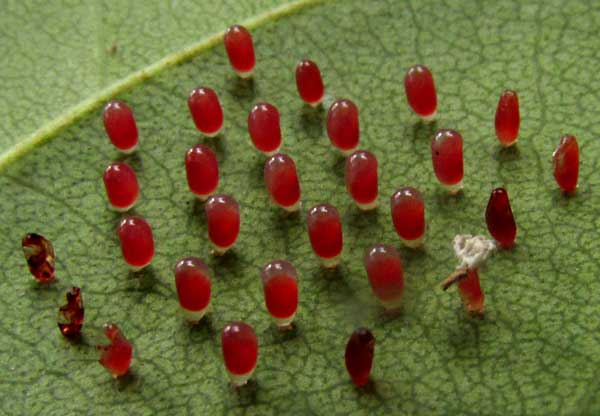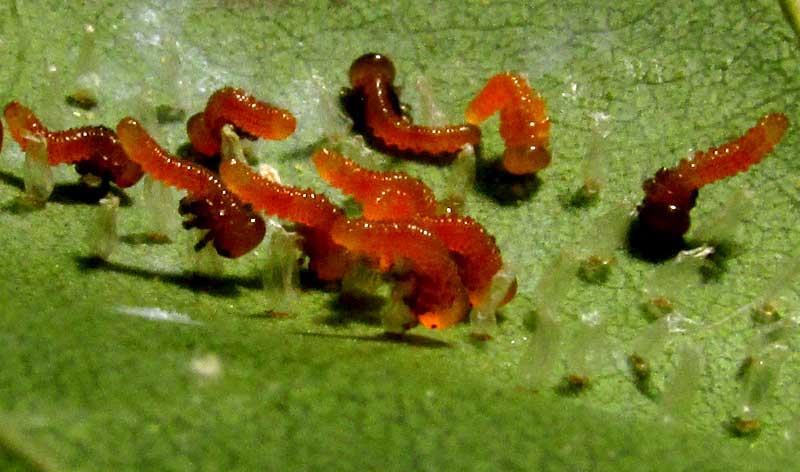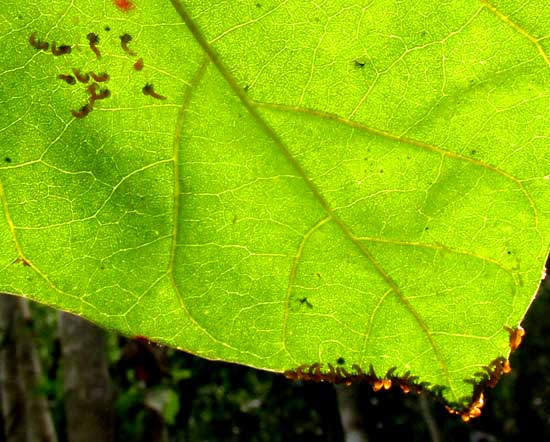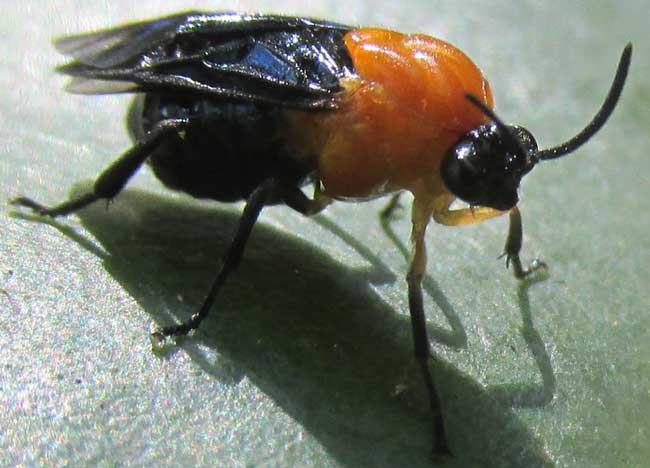Excerpts from Jim Conrad's
Naturalist Newsletter
from the January 14, 2018 Newsletter issued from Rancho Regenesis in the woods ±4kms west of Ek Balam Ruins; elevation ~40m (~130 ft), N20.876°, W88.170°; north-central Yucatán, MÉXICO
SEAGRAPE SAWFLY
It all started several months ago, during the mid rainy season. On the sapling Grape Tree, Coccoloba spicata, right in front of the hut, one morning at breakfast I noticed that one of the tree's large, leathery leaves was getting worm-eaten, and that here and there on a certain leaf something strange was showing up at the borders of the worm-eaten parts. Up close I saw what's shown below:

Tiny green caterpillars with oversized, roundish, orange heads were munching the leaves. Maybe 30 packed themselves close together along leaf margins and the margins of holes they'd eaten into the leaves, and most of them stuck the rear 4/5ths or so of their bodies into the air, causing the margins to look like they had some kind of frilly fringe. Of course each day thereafter I checked on the caterpillars' development. Below, you can see a later-stage, larger instar of one of the caterpillars holding its rear end high:

I sent my pictures to volunteer identifier Bea in Ontario, who instantly saw that they were very similar to sawfly caterpillars she'd identified in Ontario. However, the world of sawflies is enormous, so I hoped to narrow down the ID beyond that. Maybe I could even watch the caterpillars pupate, and eventually emerge as adults, at which stage Bea could give me a less general name. But then one day all the caterpillars disappeared -- probably eaten by a bird. During later weeks similar populations turned up, and all shared the same destiny, disappearing all at once before pupating.
About three weeks ago on the undersurface of one of the Grape Tree's leaves I noticed the grouping of tiny, reddish eggs shown below:

Those I checked on daily, and this week they hatched. In fact I got a fine picture showing some larvae exiting their egg shells, shown below:

Notice how the one at the far right in the picture appears to be standing on its head! As soon as the larvae left their egg shells, they migrated to the leaf's margin and began forming the earlier-seen fringe of caterpillars with their rear ends poking into the air, as shown below:

A closeup of these freshly hatched larvae at the leaf's edge is shown below:

About a month ago I'd noticed a certain boldly marked, black and orange insect flitting around the Grape Tree as if it were scouting for places to lay eggs, and I managed to get a single shot of it. This had been the only insect that for all the months I'd watched showing interest in the Grape Tree, so I wondered whether this might be the adult I'd hoped for. It didn't look like other sawflies I'd seen, but I sent the picture to Bea for her opinion. You can see it below:

Bea quickly found that a few sawfly species do look similar to our black-and-orange adult, so in all likelihood our picture showed the adult stage of the species to which the Grape Tree caterpillars belong. Bea found a species at the BugGuide.Net website very similar to ours, though it wasn't the same species. However, it belonged to the sawfly family the Tenthredinidae, and when I searched on "Yucatan Tenthredinidae" I found at the Invasive.Org website pictures showing caterpillars that were similar or identical to ours feeding on leaves of Seagrapes, which are seaside shrubs belonging not only to the same family, the Buckwheat or Knotweed Family, the Polygonaceae, but also the same genus, Coccolobo, as our Grape tree. And the adults on that page were similar or identical to the adult I'd seen visiting our Grape Tree.
So, thanks to Bea's help, now we can figure that we're dealing with a sawfly of the genus Sericoceros. Very possibly it's SERICOCEROS MEXICANUS, the species featured at the Invasive.Org site, though the colors are a little different. Searching on that name, I found a nicely illustrated and informative 2002 work in The Forestry Chronicle by William M. Ciesla entitled "Observations on the life history and habits of a tropical sawfly, Seriococeros mexicanus (Kirby), (Hymenoptera: argidae) on Roatán Island, Honduras." That work can be feely dowloaded in PDF format at http://pubs.cif-ifc.org/doi/pdf/10.5558/tfc78515-4
That paper says that about 20 Seriococeros species are recognized, but little is known about any of them. Seriococeros mexicanus has been recorded from southern Mexico south to Panama. As of the 2002 publication date, the species doesn't appear to have been documented in the Yucatan, or of feeding on the Grape Tree, Coccoloba spicata. Therefore, here either we are adding new information about Seriococeros mexicanus, or else we're dealing with a species different from that, but which can't be determined with information available.
Ciesla writes that Seriococeros mexicanus larvae build cocoons of partially chewed leaves in which they pupate. The cocoons are attached to branches, leaf petioles and leaf undersides individually or in small clusters.
That's what I'm watching for now.